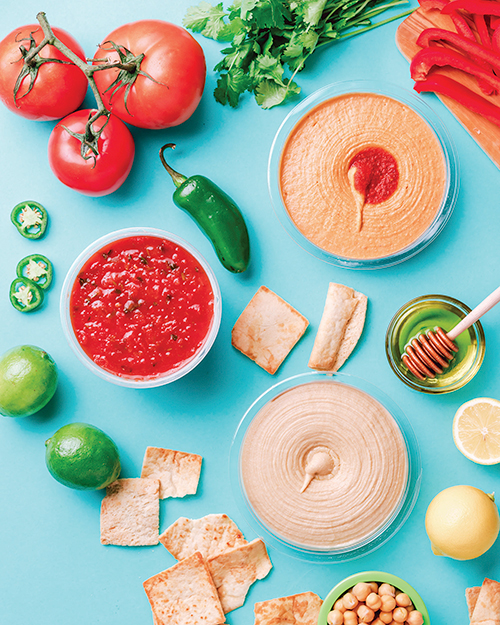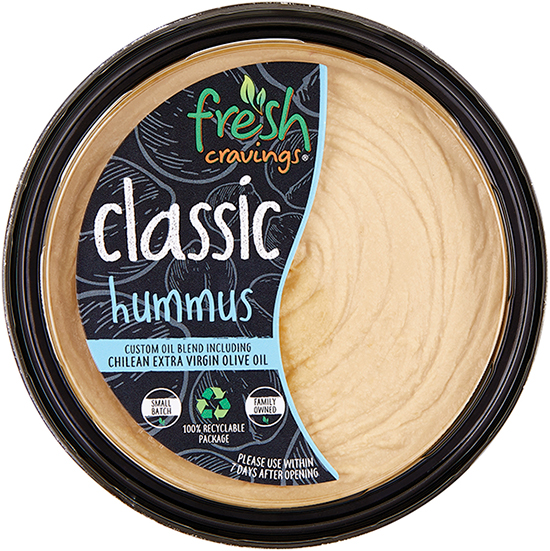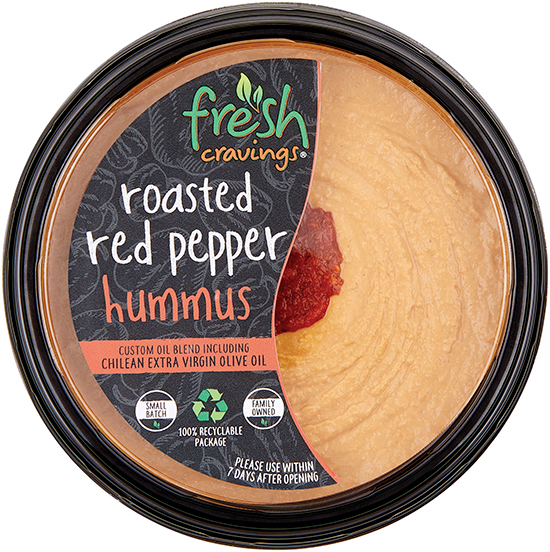HEALTHY LIVING
7 ways to snack smarter

(Family Features) Eating a balanced breakfast, lunch and dinner each day is an important part of maintaining a healthy diet, but what you eat between mealtimes can have just as much of an impact.
Eating a snack or two between traditional meals helps curb hunger and prevents overeating at mealtimes, provides an energy boost and can also help bridge nutrient gaps in your diet when you choose the right foods. On the other hand, consuming foods of little nutritional value out of boredom or habit can lead to eating too much and adding extra pounds to your waistline.

The key is taking a smart approach to snacking and making small shifts toward healthier choices. Consider these simple strategies to help you get started from the snacking experts at Fresh Cravings.
Snack Mindfully. It’s easy to overeat and overlook fullness cues when snacking in front of the TV or at a desk. Instead, treat snack time like you would a small meal and take a few minutes to eat in a designated area with limited distractions. Avoid eating out of boredom or stress and choose whole foods like fruits and vegetables or air-popped popcorn over processed chips, baked goods or candy.
Plan Ahead. Snacks can be a significant portion of many people’s daily caloric intake, so it’s important to include snacks when planning out your meals for the day or week. Include fruits, vegetables and proteins in your snack schedule and avoid refined starches and sugar, which are typically found in prepackaged and processed snacks. Planning and preparing snacks ahead of time can help you bypass those quick, unhealthy options and save money in the process, as well.
Make Healthy Snacking Easy. Keeping fruit, vegetables and other accessible nutritious ingredients in the refrigerator or pantry increases the chances you’ll reach for a better-for-you option when a snack craving strikes. Having staple ingredients on hand that can be paired with vegetables or whole-grain crackers like Fresh Cravings Hummus makes it easy to create healthy snacks. Made with high-quality ingredients like smooth Chilean extra-virgin olive oil, savory tahini, which is known to be a source of antioxidants, vitamins and minerals, and non-GMO chickpeas, the line is available in Classic Hummus, Roasted Red Pepper and Roasted Garlic varieties and can be found in 100% recyclable packaging in the produce aisle of your local grocery store.

“Look for options that are filling and nutrient-dense,” said Mia Syn, MS, RDN, a dietitian who has helped millions learn healthier, sustainable eating habits. “My preference is Fresh Cravings Hummus because it’s a great example with whole-food ingredients like tahini, Chilean extra-virgin olive oil and non-GMO chickpeas, offering a balanced mix of filling fiber, plant-based protein and good fats.”
Combine Nutrient Groups. Each time you reach for a snack, try to include two or more macronutrients (protein, fat, carbohydrates). For example, choosing foods containing protein like low-fat cheese or nuts and pairing them with carbohydrates (whole-grain crackers, grapes) can create balanced, filling snacks. Carbohydrates help provide both your body and mind with energy while protein-rich foods break down more slowly, helping you feel full longer. Other ideas include celery and peanut butter or fruit and Greek yogurt, which are easy ways to get more low-calorie, high-fiber produce into your diet.
Pay Attention to Portion Sizes. Snacks are meant to help ward off hunger between meals, not be substitutes for meals entirely. While measuring out snacks isn’t usually necessary, having an awareness of appropriate portion sizes can be helpful. If buying or cooking in bulk, divide snacks into smaller containers when meal planning to make it convenient to simply grab an appropriate size snack and continue your day.
Pack Snacks to Go. Having grab-and-go snacks packed while out running errands, working or completing everyday tasks can help keep you on track when hunger strikes. Packing items that don’t require refrigeration like trail mix, whole-grain crackers or granola bars can keep you from stopping at a convenience store or picking an unhealthy option from a vending machine. Preparing snacks at home also gives you more control over the ingredients you’re eating to ensure you’re sticking to an eating plan that’s better for your overall health.
Set a Good Example. Parents can influence children’s snack habits by consuming healthy snacks themselves. An option like sliced veggies paired with the rich flavors of chickpeas and creaminess of tahini found in hummus can be a perfect match to both satisfy hunger in a delicious way and build better-for-you habits. Snack time is also an opportunity to let kids learn about healthy eating by participating in choosing and preparing snacks. Cutting fruits and vegetables or turning foods into crafts are easy ways to get little ones involved in the process.
“For families challenged with integrating more veggies into their diets, hummus is also a kid-friendly flavor enhancer that packs beneficial nutrition instead of the saturated fats and sugar often found in many traditional dressings and condiments,” Syn said.
Smart Snack Ideas

Between work, school, extracurricular activities and family functions, it may seem like there’s no time to eat healthy when your family is seemingly always on the go. However, finding the proper fuel is even more important when you’re trying to balance a hectic schedule, which is where snacks can play an important role between meals.
Consider these nutritious snack options that can help satisfy a variety of cravings without taking up too much of that valuable time.
Crunchy Munchies
- Apples or pears
- Carrot and celery sticks
- Cucumber or bell pepper slices
- Air-popped popcorn
- Brown rice cakes
- Nuts and seeds
Low-Sugar Sips
- Plain or sparkling water (add fruit or herbs for extra flavor)
- Unsweetened tea or coffee
- 100% vegetable or fruit juices with no added sugars
Satisfying Noshes
- Sliced vegetables with Fresh Cravings Classic, Roasted Red Pepper or Roasted Garlic Hummus
- Fruit and vegetable smoothies
Find more ideas to satisfy snack cravings at freshcravings.com.
Photo courtesy of Getty Images (Friends snacking)
SOURCE:
Fresh Cravings
HEALTHY LIVING
Promote health with these daily habits

Health should be a priority, but too often life gets in the way and individuals take a reactive, rather than proactive, approach to their personal well-being. But living healthier need not be so difficult. In fact, research suggests that small, positive changes in how a person lives each day creates a healthier person over time.
A Hologic-Gallup survey on the state of women’s health conducted in April 2024 found 63 percent of respondents said it was hard for them to make health a priority. They cited feeling overwhelmed, needing to care for others before themselves, emotional/mental health, and work as the top barriers to focusing on health. But it’s important that both women and men recognize that small changes can add up to big results. These healthy habits can help individuals start living healthier lifestyles.
· Get some exercise. Regular physical activity is one of the most important things a person can do fo his or her health. Exercise helps manage weight, reduces the risk of disease, strengthens bones and muscles, and improves brain health. The Centers for Disease Control and Prevention says adults should aim for at least 150 minutes (30 minutes a day for five days) of moderate-intensity aerobic activity a week. A great place to begin is with a daily walk, which is a simple and effective habit that does not require a lot of time and no equipment except a good pair of athletic shoes.
· Wear sunscreen every day. After washing your face each morning, apply a facial moisturizer with an SPF of at least 30, or blend equal parts of sunscreen and regular moisturizer, suggests Harvard Health. Use it on the face, neck, ears, and any thinning hair spots on the scalp. Skin cancer is the most common type of the disease worldwide, and wearing sunscreen can help many people avoid it.
· Spend time outdoors. It takes just a few minutes in the sun to raise vitamin D levels. Vitamin D is necessary for bone and heart health and helps to boost mood, says WebMD. Various studies indicate spending time in green spaces promotes calm and increases happiness.
· Plan your meals. Meal planning is not just a way to manage food budgets. It’s also a great method to being more mindful of food choices and avoiding impulse buys or meals that may not be as healthy as they can be. Adding more plant-based foods to a diet is a good start. Such foods can reduce the risk of chronic conditions like high cholesterol and hypertension.
· Stay hydrated. Hydration supports good digestion, increases energy and may improve brain performance, states Harvard Health. Drink a glass of water each day upon waking up and with every meal. Older adults often do not feel thirst like they did when they were younger, so it is especially important for seniors to stay hydrated.
Healthy habits are more easily adopted when people begin small and make a daily commitment to their overall health.
HEALTHY LIVING
Make a smart home investment with an all climate heat pump

(Family Features) If your home uses a conventional heating and cooling system, you may wonder if there’s a better way to manage indoor comfort. Between rising energy costs and concerns about the efficiency of conventional systems, many homeowners are exploring alternatives. One popular solution is an all-climate heat pump.
All-climate heat pumps are the next generation of heat pump technology built for peak performance, regardless of the outdoor temperature. From the personalized comfort all-climate heat pumps deliver to the energy savings realized, it’s no wonder more homeowners are considering going all-in on all-climate.
If you’re considering replacing your current HVAC system, read on for some of the benefits of all-climate heat pumps.
Personalized Comfort
Ductless, multi-zone, all-climate heat pump systems are designed to deliver personalized, room-to-room temperature control tailored to your preferences. Unlike traditional ducted unitary systems, which typically operate on an all-or-nothing basis, ductless multi-zone solutions provide individualized climate settings for each space. Whether you prefer a warmer living room or a cooler bedroom, the flexibility to adjust each zone offers unparalleled convenience and energy efficiency.
Efficiency
According to a survey of U.S. homeowners commissioned by Mitsubishi Electric Trane HVAC US (METUS), 93% of homeowners surveyed with conventional HVAC systems reported concerns about utility bills. Seventy-five percent of those surveyed also consider energy efficiency always or often when considering home improvements.
Conventional heating and cooling systems run at full capacity to reach set point and then shut off. The start-stop action ultimately wastes energy. With variable-capacity capabilities and inverter-driven technology, all-climate heat pumps can adjust and maintain temperatures, lessening your home’s overall energy demand and driving down cost.
Cost Savings
The cost savings provided by efficient energy usage are evident. Additionally, some states offer rebates for new HVAC systems, and many contractors offer financing options, which make the upfront cost of an all-climate heat pump installation more affordable.
Reliability is another cost-saving factor. All-climate heat pumps are purpose-built with durable materials to perform well in all kinds of weather.
“We continue to educate homeowners about the advantages all-climate heat pumps have over conventional HVAC systems,” said Mark Kuntz, Chief Executive Officer, METUS. “As homeowners become more knowledgeable about the numerous benefits, including personalized comfort, energy efficiency and cost savings, we believe they will increasingly install these next-generation systems in their homes.”
Learn more about how you can better manage your home’s indoor comfort with all-climate heat pump technology by visiting mitsubishicomfort.com.
SOURCE:
Mitsubishi Electric
HEALTHY LIVING
How to protect your pet’s dental health

(Family Features) Like humans, pets’ oral hygiene plays an important role in their overall health and quality of life. Common conditions like plaque buildup, tartar and bad breath can escalate to serious health conditions if untreated.
In fact, by the age of 3, 80% of pets experience some form of dental health issue, and the risk only increases as they age. However, for many pet owners, taking care of their four-legged friends’ oral health is a more difficult habit to maintain than their own daily brushing and flossing routine.
Many veterinarians recommend regular brushing for pets, and a wide array of treats and meal additives complement brushing to help support your pet’s oral health.
Protecting your pet’s oral health begins by talking with your veterinarian, who can provide recommendations tailored to your pet’s specific needs. With that guidance, you can start comparison shopping and reading labels so you can identify quality products. Remember you’re likely to find the greatest success by introducing oral health products as part of your pet’s daily routine early on.
Certifications for Trust and Quality
awarded to products that meet strict standards for controlling plaque and tartar. You can find the seal on packaging as an easy visual indication of the product’s quality standards.
Natural, Effective Ingredients
Look for products that prioritize safety and health by offering natural, clinically proven ingredients and no artificial additives or chemicals. Seaweed (or kelp) is a preferred ingredient because it contains minerals and enzymes that help reduce plaque and prevent bacteria.
You can find 100% natural and organic kelp in products like ProDen PlaqueOff®, which includes A.N ProDen®, a kelp ingredient sustainably harvested from specially selected locations in the pristine North Atlantic waters off the Scandinavian coastline. Processed through a specialized method in extreme environmental conditions, it attains peak quality and effectiveness, ensuring safety and health for your pet.
Sustainable Practices
Another detail you can gather from the product’s packaging is whether a product manufacturer adheres to environmentally friendly practices and safe ingredient sourcing, which means the product is not only good for pets but also for the planet. This may be evident in certifications or special icons on the packaging, through information about sustainably harvested ingredients or with packaging that itself is environmentally responsible.
Tailoring to Individual Pets
Different pets have different needs based on age, size, breed and oral health status. Selecting the right product may also be complicated by your pet’s allergies or picky eating habits. You can find a variety of ingestible options, including powders, chews or bones like those offered by ProDen PlaqueOff®, to use in conjunction with daily brushing.
- Powder: Ideal for a seamless addition to your pet’s diet, this is the most economical choice, particularly for long-term use. It’s especially suitable for younger pets as a preventive measure, given its longevity and cost-effectiveness.
- Chews: For those looking for an easy-to-administer option that doubles as a reward, chews are the way to go. Additionally, for older pets or those with missing teeth, soft chews can offer a gentle yet effective way to maintain oral health. They’re a convenient choice for pet owners to give as a daily dose without the need for measuring or mixing.
- Bones: Designed not only to satisfy your dog’s natural chewing instincts but also to aid in dental care, bones are a perfect option for pet parents whose dogs prefer a longer-lasting treat. Bones come in a variety of flavors and sizes, catering to both large and small breeds, making them a versatile way to help keep your dog’s teeth clean and their breath fresh.
Learn more about protecting your pet’s dental health at us.swedencare.com.
Photo courtesy of Shutterstock (veterinarian examining dog)
SOURCE:
Swedencare
-

 NEWS2 years ago
NEWS2 years ago2 hurt, 1 jailed after shooting incident north of Nocona
-

 NEWS1 year ago
NEWS1 year agoSuspect indicted, jailed in Tia Hutson murder
-

 NEWS2 years ago
NEWS2 years agoSO investigating possible murder/suicide
-

 NEWS2 years ago
NEWS2 years agoWreck takes the life of BHS teen, 16
-

 NEWS2 years ago
NEWS2 years agoMurder unsolved – 1 year later Tia Hutson’s family angry, frustrated with no arrest
-

 NEWS2 years ago
NEWS2 years agoSheriff’s office called out to infant’s death
-

 NEWS2 years ago
NEWS2 years agoBowie Police face three-hour standoff after possible domestic fight
-

 NEWS2 years ago
NEWS2 years agoDriver stopped by a man running into the street, robbed at knifepoint







